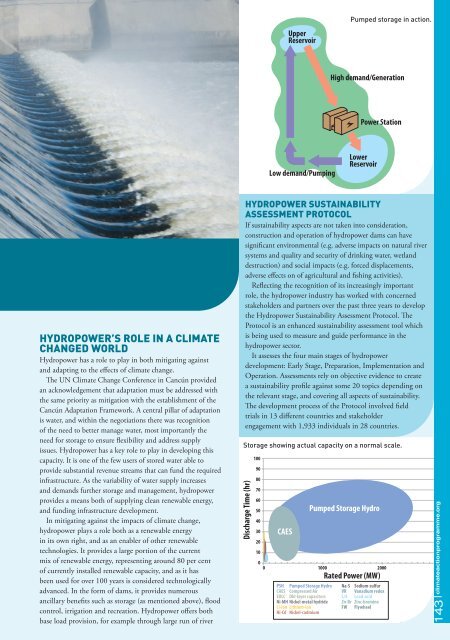Climate Action 2011-2012
You also want an ePaper? Increase the reach of your titles
YUMPU automatically turns print PDFs into web optimized ePapers that Google loves.
Upper<br />
Reservoir<br />
Pumped storage in action.<br />
High demand/Generation<br />
Power Station<br />
Low demand/Pumping<br />
Lower<br />
Reservoir<br />
hydropower’S role In a clImate<br />
changed world<br />
Hydropower has a role to play in both mitigating against<br />
and adapting to the effects of climate change.<br />
The UN <strong>Climate</strong> Change Conference in Cancún provided<br />
an acknowledgement that adaptation must be addressed with<br />
the same priority as mitigation with the establishment of the<br />
Cancún Adaptation Framework. A central pillar of adaptation<br />
is water, and within the negotiations there was recognition<br />
of the need to better manage water, most importantly the<br />
need for storage to ensure flexibility and address supply<br />
issues. Hydropower has a key role to play in developing this<br />
capacity. It is one of the few users of stored water able to<br />
provide substantial revenue streams that can fund the required<br />
infrastructure. As the variability of water supply increases<br />
and demands further storage and management, hydropower<br />
provides a means both of supplying clean renewable energy,<br />
and funding infrastructure development.<br />
In mitigating against the impacts of climate change,<br />
hydropower plays a role both as a renewable energy<br />
in its own right, and as an enabler of other renewable<br />
technologies. It provides a large portion of the current<br />
mix of renewable energy, representing around 80 per cent<br />
of currently installed renewable capacity, and as it has<br />
been used for over 100 years is considered technologically<br />
advanced. In the form of dams, it provides numerous<br />
ancillary benefits such as storage (as mentioned above), flood<br />
control, irrigation and recreation. Hydropower offers both<br />
base load provision, for example through large run of river<br />
hydropower SuStaInabIlIty<br />
aSSeSSment protocol<br />
If sustainability aspects are not taken into consideration,<br />
construction and operation of hydropower dams can have<br />
significant environmental (e.g. adverse impacts on natural river<br />
systems and quality and security of drinking water, wetland<br />
destruction) and social impacts (e.g. forced displacements,<br />
adverse effects on of agricultural and fishing activities).<br />
Reflecting the recognition of its increasingly important<br />
role, the hydropower industry has worked with concerned<br />
stakeholders and partners over the past three years to develop<br />
the Hydropower Sustainability Assessment Protocol. The<br />
Protocol is an enhanced sustainability assessment tool which<br />
is being used to measure and guide performance in the<br />
hydropower sector.<br />
It assesses the four main stages of hydropower<br />
development: Early Stage, Preparation, Implementation and<br />
Operation. Assessments rely on objective evidence to create<br />
a sustainability profile against some 20 topics depending on<br />
the relevant stage, and covering all aspects of sustainability.<br />
The development process of the Protocol involved field<br />
trials in 13 different countries and stakeholder<br />
engagement with 1,933 individuals in 28 countries.<br />
Storage showing actual capacity on a normal scale.<br />
Discharge Time (hr) (hr)<br />
100<br />
100<br />
90<br />
90<br />
80<br />
80<br />
70<br />
70<br />
60 60<br />
50 50<br />
Pumped Storage Hydro Hydro<br />
40<br />
30 CAES<br />
20 20<br />
10<br />
10<br />
0<br />
0 0 1000 2000<br />
0 1000 2000<br />
Rated Power (MW)<br />
Rated Power (MW)<br />
PSH Pumped Storage Hydro Na-S Sodium-sulfur<br />
CAES PSH Compressed Pumped Storage Air Hydro VR Na-S Vanadium Sodium-sulfur<br />
redox<br />
EDLC CAES Dbl-layer Compressed capacitors Air<br />
L/A VR Lead-acid Vanadium redox<br />
Ni-MH<br />
EDLC<br />
Nickel-metal<br />
Dbl-layer capacitors<br />
hydride Zn-Br<br />
L/A<br />
Zinc-bromine<br />
Lead-acid<br />
Li-Ion Lithium-ion<br />
FW Flywheel<br />
Ni-Cd Ni-MH Nickel-cadmium<br />
Nickel-metal hydride Zn-Br Zinc-bromine<br />
Li-Ion Lithium-ion<br />
FW Flywheel<br />
Ni-Cd Nickel-cadmium<br />
143 climateactionprogramme.org












